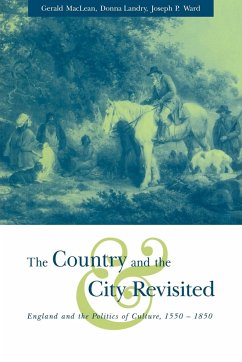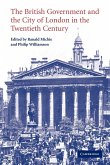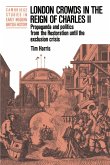A revisionist interdisciplinary study of the transformation of England into an imperial power between 1550 and 1850.
Between 1550 and 1850, the great age of mercantilism, the English people remade themselves from a disparate group of individuals and localities divided by feudal loyalties, dialects and even languages, into an imperial power. Examining literature, art and social life, and returning to ground first explored by Raymond Williams in his seminal work, The Country and the City Revisited traces this transformation. It shows that what Williams figured as an urban-rural dichotomy can now be more satisfactorily grasped as a permeable boundary. While the movement of sugar, tobacco and tea became ever more deeply interfused with the movement of people, through migration and the slave trade, these commodies initiated new conceptions of space, time and identity. Spanning the traditional periods of the Renaissance and Romanticism, this collection of essays offers exciting interdisciplinary perspectives on central issues of early modern English history.
Review quote:
"In identifying the culture of setting as a shared window onto awareness and experience in former times, all the contributors point to a very promising framework in which a refreshingly interdisciplinary enterprise of British studies could evolve."
Carl B. Estabrook, Albion
Table of contents:
List of illustrations; Notes on contributors; Acknowledgments; Abbreviations and notes on the text; 1. Introduction: the country and the city revisited, c. 1550-1850 Gerald MacLean, Donna Landry and Joseph P. Ward; 2. Imagining the metropolis in Elizabethan and Stuart London Joseph P. Ward; 3. The peripatetic muse: internal travel and the cultural production of space in pre-revolutionary England Andrew McRae; 4. The Cookes and the Brookes: uses of portraiture in town and country before the Civil War Robert Tittler; 5. Digger writing and rural dissent in the English Revolution: representing England as a common treasury David Loewenstein; 6. 'Gulfes, Deserts, Precipices, Stone': Marvell's 'Upon Appleton House' and the contradictions of 'nature' Robert Markley; 7. Enthusiasm and Enlightenment: of food, filth and slavery Nigel Smith; 8. 'What is the country?': patriotism and the language of popularity during the English militia reform of 1757 Eliga Gould; 9. Who's making the scene? Real people in eighteenth-century topographical prints Richard Quaintance; 10. Imperial georgic, 1660-1789 Karen O'Brien; 11. The gentleman planter and the metropole: Long's History of Jamaica (1774) Elizabeth A. Bohls; 12. Crown forests and female georgic: Frances Burney and the reconstruction of Britishness Elizabeth Heckendorn Cook; 13. 'Wild outcasts of society': the transit of the Gypsies in Romantic period poetry Anne F. Janowitz; 14. Afterword: moving stories, still lives John Barrell; Index.
Hinweis: Dieser Artikel kann nur an eine deutsche Lieferadresse ausgeliefert werden.
Between 1550 and 1850, the great age of mercantilism, the English people remade themselves from a disparate group of individuals and localities divided by feudal loyalties, dialects and even languages, into an imperial power. Examining literature, art and social life, and returning to ground first explored by Raymond Williams in his seminal work, The Country and the City Revisited traces this transformation. It shows that what Williams figured as an urban-rural dichotomy can now be more satisfactorily grasped as a permeable boundary. While the movement of sugar, tobacco and tea became ever more deeply interfused with the movement of people, through migration and the slave trade, these commodies initiated new conceptions of space, time and identity. Spanning the traditional periods of the Renaissance and Romanticism, this collection of essays offers exciting interdisciplinary perspectives on central issues of early modern English history.
Review quote:
"In identifying the culture of setting as a shared window onto awareness and experience in former times, all the contributors point to a very promising framework in which a refreshingly interdisciplinary enterprise of British studies could evolve."
Carl B. Estabrook, Albion
Table of contents:
List of illustrations; Notes on contributors; Acknowledgments; Abbreviations and notes on the text; 1. Introduction: the country and the city revisited, c. 1550-1850 Gerald MacLean, Donna Landry and Joseph P. Ward; 2. Imagining the metropolis in Elizabethan and Stuart London Joseph P. Ward; 3. The peripatetic muse: internal travel and the cultural production of space in pre-revolutionary England Andrew McRae; 4. The Cookes and the Brookes: uses of portraiture in town and country before the Civil War Robert Tittler; 5. Digger writing and rural dissent in the English Revolution: representing England as a common treasury David Loewenstein; 6. 'Gulfes, Deserts, Precipices, Stone': Marvell's 'Upon Appleton House' and the contradictions of 'nature' Robert Markley; 7. Enthusiasm and Enlightenment: of food, filth and slavery Nigel Smith; 8. 'What is the country?': patriotism and the language of popularity during the English militia reform of 1757 Eliga Gould; 9. Who's making the scene? Real people in eighteenth-century topographical prints Richard Quaintance; 10. Imperial georgic, 1660-1789 Karen O'Brien; 11. The gentleman planter and the metropole: Long's History of Jamaica (1774) Elizabeth A. Bohls; 12. Crown forests and female georgic: Frances Burney and the reconstruction of Britishness Elizabeth Heckendorn Cook; 13. 'Wild outcasts of society': the transit of the Gypsies in Romantic period poetry Anne F. Janowitz; 14. Afterword: moving stories, still lives John Barrell; Index.
Hinweis: Dieser Artikel kann nur an eine deutsche Lieferadresse ausgeliefert werden.








